Many districts and schools are now regularly collecting data assessing students’ social-emotional and behavioral skills. Data from assessments and screeners are typically used to identify students needing additional support. Other pieces of data, such as behavior monitoring or tracking, are commonly used to track the progress students are making toward their goals.
In most schools and districts, specialists, school psychologists, and counselors are responsible for collecting and/or using these types of data; however, classroom teachers can also gain important insights from these data in understanding what kinds of lessons and approaches they can be using in the classroom. The biggest barrier to this work is knowing how universal screener and behavioral data can be used to inform the strategies being used in the Tier 1 context. The following are steps that educators can take to help leverage available data to inform their SEL and behavior strategies and practices in their classrooms.
Step 1: Identify Different Sources of Data
Does your school use student surveys to assess things such as climate, sense of belonging, relationships, and other indicators of social-emotional competencies and well-being? If so, it is important to understand what these surveys are measuring in order to effectively use data collected from them. Review the questions that students or staff are being asked closely and see how each question is related to an overall skill area or indicator of student well-being. Often the questions themselves can be used to develop specific classroom strategies or opportunities to practice the skill.
If your school doesn’t use universal surveys or assessments there could be other mechanisms for collecting data. Some classrooms collect data on student behaviors through programs like ClassDojo or Check-in/Check-out sheets.
Depending on how the data is collected, student behavior incidents can also provide useful information for teachers. When using this type of behavioral data you might need to start collecting some additional information to understand more context about the behavior—for example:
- Was there a specific event that triggered the behavior?
- Where and when did it occur?
- And what was done in response to the behavior?
It can also be helpful to not just focus on the negative behavior but try and understand the underlying skill, competency, or support that the student might need help with in order to prevent these types of behaviors from occurring more regularly.
Step 2: Decide on a Time Frame for Reviewing Data
Unlike academic assessments and screeners, it is difficult to accurately assess certain aspects of social-emotional competence right at the beginning of the school year. Most surveys and assessment providers recommend waiting at least one month before assessing these skills and needs. The same goes for any kind of behavioral progress monitoring or incident data. This is because students need time to adjust to the classroom environment. Also, if there are certain behavioral concerns, it might take a few weeks for these to become regular enough that they are easily understood and identifiable.
Reviewing data does not only need to be done by teachers and staff; students can also participate in data review sessions. When including students, it is important to never single out individual student scores or responses, but instead discuss trends or aggregate observations to get student input and ideas.
When developing a timeline, consider who will be included in reviewing the data and how much time you will need to dedicate to that step. This shouldn’t be pushed off too far as you want to leave enough time to develop and implement strategies.
➡️ Additional Resource: Washoe County SECA Debriefing Toolkit
Step 3: Leverage Available Platforms and Tools To Help Display and Interpret Data
Being able to collect data is one thing, but being able to easily review and interpret the data is another. Some districts use platforms that display data in easily understandable ways. At Branching Minds, we strive to make data accessible for all stakeholders. An example of this is our Cohort Assessment Performance Report (CAPR) which can be used to review assessment data across groups or cohorts of students. This data is also summarized across different assessment windows to provide insight into how students develop different skills measured over time.
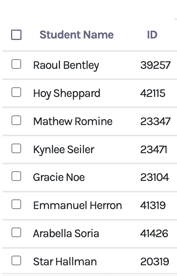 |
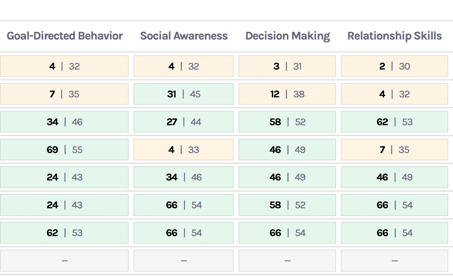 |
Not only should data be viewable, but it should also be actionable, meaning that the results displayed can be then used to intervene in some way. For example, in the CAPR, educators can select specific students and put them in a group, assign them to a specific intervention plan or strategy, document a family communication, or add a supporting document (see example below). If your school or district does not have access to a data report or platform, school leaders should ensure that all staff is aware of the next steps that should be taken after the data has been reviewed.
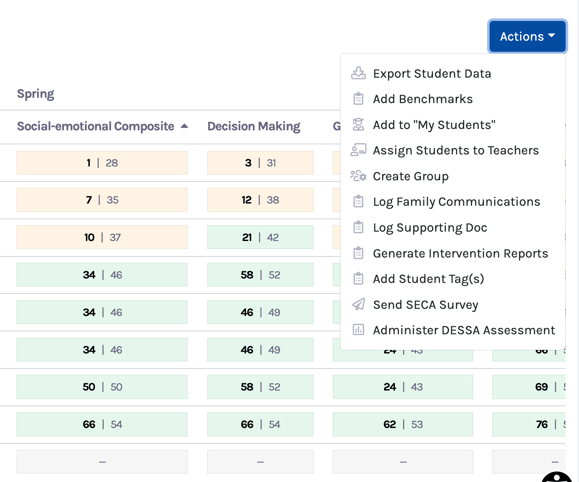
Step 4: Identify Both Strengths and Needs of Students
Sometimes teachers will recognize several different areas of need among their students and not know how to address all of these needs at once. It is a good practice to start by focusing on one area. Many social-emotional/behavioral skills are interconnected, so even if you are focusing on only one skill, you will likely be impacting another. It is also much more feasible for teachers and students to focus on one thing at a time.
Another valuable approach is to look at the skills or areas where students excel and use that as a springboard for teaching/focusing on areas that need support. For example, teachers might have classrooms with students who excel in their social skills and relationships but need support when it comes to self-regulation.
There might be opportunities for these students to learn from their peers through activities and lessons that foster a lot of social interaction and discussion around the topic of self-regulation. These social-emotional strengths can also be used in academic learning and provide an opportunity to keep students engaged, interested, and motivated.
Step 5: Leverage SEL Curricula, Programs, and Practices To Teach Specific Skills
Many schools have a universal SEL or behavior-based program, curriculum, or framework that they are currently using to support these skills and competencies. If your school does not have a universal program, there are some evidence-based free programs, such as Harmony SEL and Kindness in the Classroom. Most lessons, activities, or practices embedded within a program will outline the specific competency or skill that it targets. There might also be extension activities or lessons aligned to each skill area.
Once you’ve identified the specific skill or competency that you will focus on, it is a good idea to identify what extra lessons, activities, or daily practices you can use to help support this skill. This is not to say that you shouldn’t use your SEL programs in the sequence that it was designed—that is still a very important component of SEL implementation fidelity. But there may be certain pieces of your SEL program that can be emphasized and extended depending on the specific needs of your students. For example, Harmony SEL program’s unit on Communication has several activities and games to help support listening to others. These can continue to be implemented even after the unit has been completed.
Another effective approach is to find resources from a program or curriculum to help integrate SEL into academic learning. Asking students to reflect on the feelings and actions of characters in a story or novel is a great way to bring SEL into Reading and ELA. Skills such as self-awareness can be promoted in Math and Science when students are being taught how and why it is important to check your work or go back to figure out where they might have made an error.
In other words, whichever skill you choose to focus on with your students, think of how it can be taught or reinforced throughout their learning, not only within the context of an SEL lesson or program.
Step 6: Review Student Progress
Once you have been implementing a tool, program, strategy, or practice consistently over an extended period, it is important to consider ways to measure student progress or growth. Similar to Step 1, educators can identify different sources of data that they can use to help quantify the changes in student skills and behavior over time. This will help you know whether or not your efforts are having an impact.
Experts suggest that it can take 60-90 days to see changes in student behavior in response to implementing ongoing SEL programs and/or strategies. Therefore, you shouldn’t expect to see changes in students overnight. A lot of success with SEL also comes down to high-quality implementation over a long period of time. Nevertheless, sometimes students do not respond to certain types of approaches, and teachers need to recognize when this is the case and be willing to try something new or dig deeper into the data to understand why certain approaches may not be effective. In these situations, it is also helpful to seek support from additional staff, such as counselors and specialists, to problem-solve and determine where adjustments need to be made.
Collecting & Using Data is an Ongoing Process…
It is not uncommon for educators to find the practice of collecting and using data to be intimidating or outside of their wheelhouse. Despite this apprehension, many teachers and educators collect data without realizing it. It is an ongoing process to figure out ways to leverage that data and have it inform what goes on in your classroom. Starting small, using data that is understandable and accessible, and figuring out how that information connects to what is being done in the classroom is a great place to start.
➡️ On-Demand Webinar: Best Practices for Using SEL Data in MTSS (A Webinar with Athens ISD)
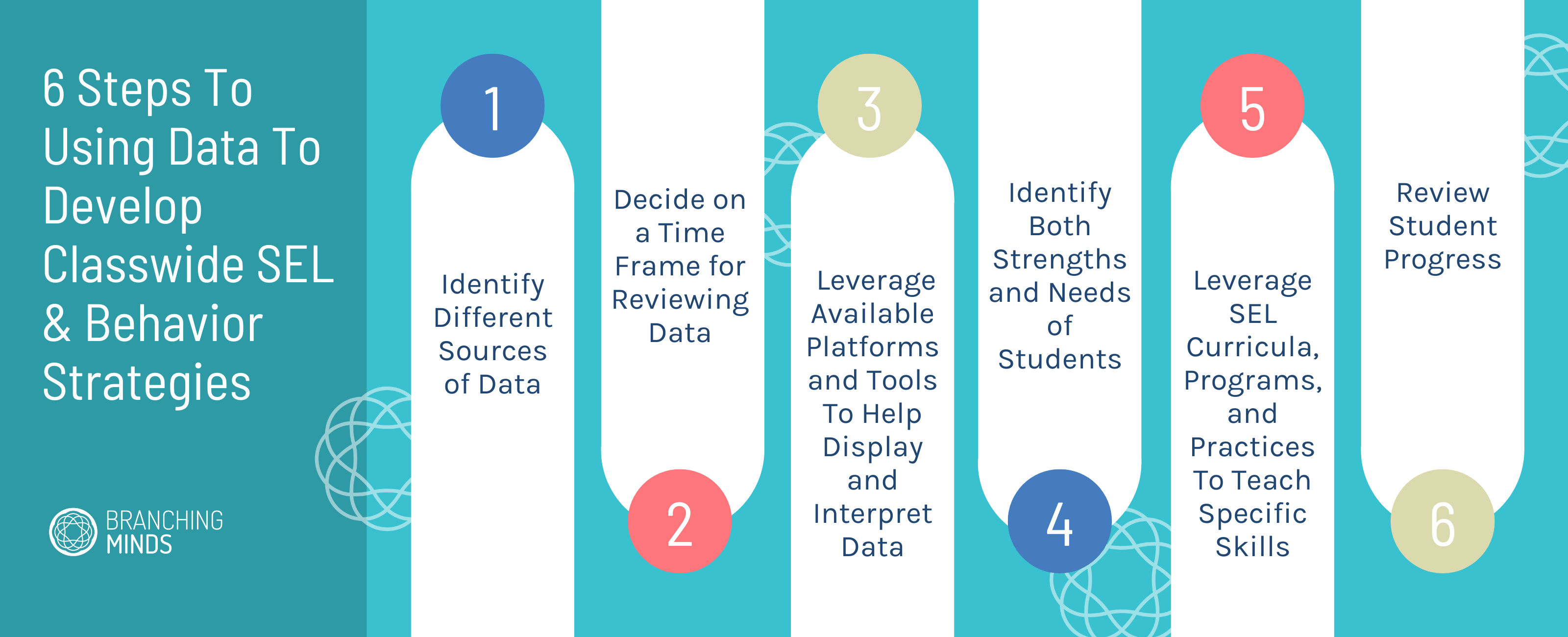 |
Related resources you may find helpful:
|
|
Interested in Learning How to Support the Whole Child with Branching Minds?Branching Minds makes MTSS easy, efficient, and effective by bringing together all of the components of MTSS so teachers can collaboratively problem-solve and support all students’ holistic needs. Our system-level solution helps schools improve students’ outcomes across academics and behavior. Our platform supports teachers with Behavior and SEL in the following ways: ✅ Assessing SEL Needs with the DESSA
✅ Understand Students Perception of their Own SEL Competence with the SECA ✅ Leveraging SEL Screeners for Tiering ✅ More effective problem-solving ✅ Finding the Right Evidence-based Interventions & Accommodations for Each Learner ✅ Creating Intervention Plans and Monitoring Daily & Weekly Progress in Behavior/SEL ✅ Logging & Monitoring Behavior Incidents ✅ Pattern Matching Behavior Incidents Across Groups
|
|

About the author
Dr. Essie Sutton
Essie Sutton is an Applied Developmental Psychologist and the Director of Learning Science at Branching Minds. Her work brings together the fields of Child Development and Education Psychology to improve learning and development for all students. Dr. Sutton is responsible for studying the impacts of the Branching Minds on students’ academic, behavioral, and social-emotional outcomes. She also leverages MTSS research and best practices to develop and improve the Branching Minds platform.

Your MTSS Transformation Starts Here
Enhance your MTSS process. Book a Branching Minds demo today.













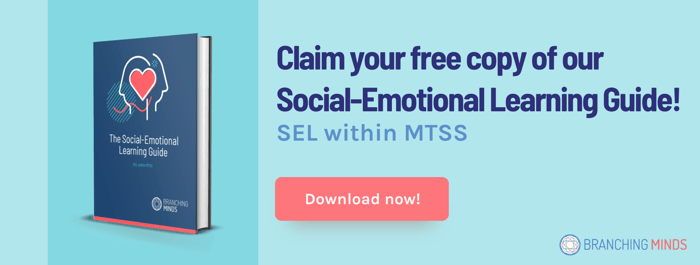


.png?width=716&height=522&name=Addressing%20Foundational%20Reading%20Skills%20in%20MTSS%20(preview).png)
.png?width=716&height=522&name=Understanding%20Literacy%20Basics%20(Preview).png)
